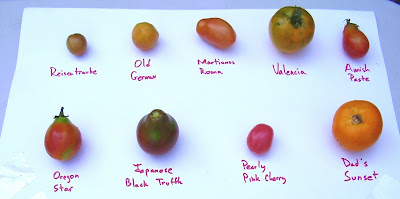On Saturday, September 12 we welcomed volunteers from Chicago Cares and with their help, picked a total of 212 pounds of fruit and veg to donate to Vital Bridges' Groceryland food pantry.
We also saved seeds from about 15 tomato varieties for planting next year, and rounded out the day with a pot-luck to send off our star volunteer, John Cahill, who is moving to Massachusetts.
Our haul this week included two crates of pears, 60 pounds of plums (two crates like the one below)

48 pounds of tomatoes, our first really red bell peppers

pumpkins, cucumbers, patty-pan squash, collards, kale, and a host of other goodies.
With the harvest picked and heading off to Vital Bridges, we turned to a few seasonal tasks. One group picked herbs for drying, another scraped paint off benches in the front garden (we'll seal these with soy sealer before the weather gets too wet), and others weeded the more recently sown beds.
After a while, we brought everyone together to help with saving tomato seeds from some of the varieties we grew this year. We started by assembling a collection of some of the weirdest, most prolific and best tasting fruits known to homo chicagoensis.


Then we assembled a fine collection of willing volunteers and instructed them in the simple art of saving tomato seeds. You start by selecting a fully ripe tomato from a variety you enjoyed. Then you slice it vertically into chunks and separate the seeds from the flesh in a bowl of clean water.

Unbelievably, one of our longer-serving volunteers then instructed people to take the tomato flesh and throw it in the compost pile. It took a particularly smart Chicago Cares volunteer to come up with the bright idea of just eating the leftover tomatoes, instead.
Then, the next task is to strain the water off the seeds. Our makeshift solution for this was a mesh floored seed tray that has been sitting behind the shed for as long as we can remember.

After that we scraped each variety of seeds into it's own small pot to begin the only slightly counter-intuitive part of the process: fermenting the seeds for 3-7 days in order to rot away the gel coating on each one. The gel contains a chemical that suppresses germination, so it has to be removed before the seed can be dried and stored. The seed pots have to be fermented until they have a thick coat of mold on the surface. But at the start of the process, they look pretty appealing:

We finished up the day with a pot-luck send-off for John Cahill, volunteer, writer and former carpenter. We wish him well in Massachusetts. (Check out those garden-grown tomatoes, basil and sorrel upon which we feasted!)


